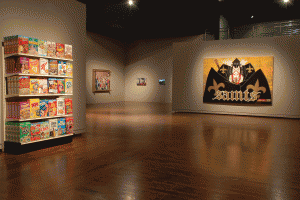« Reviews
All American: Defining Ourselves in a Time of Change

“All American: Defining Ourselves in a Time of Change,” exhibition view. Courtesy Salt Lake Art Center.
Salt Lake Art Center – Salt Lake City, Utah
July 1 – October 31, 2009
By Cara Despain
If the aesthetic of American culture could be defined, what might the explanation entail? There may be more—or less—than meets the eye. Dealing with this aesthetic via contemporary art icons, symbols, and traditions can reflect the story of heritage, make a critical comment about our modern way of life, or merely make a statement that could be read as either patriotic or sardonic. “All American,” the current exhibition at the Salt Lake Art Center, reflects not only what the title suggests, but also what one would likely expect to find in an exhibition of this theme—diverse approaches dealing with different facets of Americana that more or less seem to allude to similar sentiments.
The show reveals that “America is …[dot, dot, dot]” says SLAC curator of exhibitions Jay Heuman; that is, the U.S. is often referred to as a “melting pot” with no real defining characteristic or cultural standard. But the adverse is also true—there are several aspects of the “American Dream” that are called to mind with a high level of specificity. The thirteen artists in the show (Eric Beltz, Joe Compean, Jacqueline Goss, Gajin Fajita, Patrick Lichty, Jerry Bleem, Robert Reynolds, Scott Grieger, Brian Dettmer, Tracy Linder, Steven B. Smith, and Brad Slaugh)—a loose reference to the original colonies—react to and reflect this sort of paradox and address the theme through three prominent angles: history, economy/geo-economics, and cultural/cross-cultural issues.
Eric Beltz’s fastidious graphite works tackle American history with what Heuman refers to as “invented aphorisms”—“it is not always easy to attain an audience with the gods,” “while conscience claps let the world hiss”—that imbue the work with cryptic and bold mantras. Visually terse to an amazing degree, Beltz’s drawings reevaluate the role of the founding fathers, and examine the erring ways of early agricultural practices. They are insanely detailed, intimate, very direct comments about our history that are delivered in a somewhat unexpected format—you might think of a work that packs such a punch as being imposing or overbearing in size and medium. That these are tight, tidy little drawings seems to show that the artist’s message was concise and clear from the onset and did not require all the bells and whistles.
In fact, much of the work in the exhibition is without the in-your-face, brazen attack plan that much political art suffers from. Even Scott Grieger’s large-scale reproduction of United States of Anxiety is loud without screaming. Interestingly, the show has a strangely grim flavor; to the economic/geo-economic end there are several works and installations that point to the false exteriors and facades that have worked themselves into our everyday life. Steven B. Smith’s photos for this reason are unpleasant to look at; they are awful scenes from Ivins, Utah—Washington county has been among the fastest growing areas in the country for several years, and the growing pains are evident—showing fabricated rocks, both concrete and plastic, and other visually assaulting manmade faux-natural objects against the backdrop of the beautiful southern Utah desert. The contrast makes them very effective, and reveals what just may be the nasty aesthetic of the New World—or at least the new west.
The notion of “Manifest Destiny” seems to have had a cultural impact on America. By and large, suburban standards of operation have come to dictate behavior and in many ways identity. The idea of claiming space both as an individual and a society is an interesting thing. Robert Reynolds addresses this via a consumerist approach. Bringing an actual supermarket shelving unit full of cereal boxes, he re-creates the generic experience of an American grocery store. The only altered box is a limited edition series of Wheaties that juxtaposes this life with global politics in the Middle East that, if noticed and read is very satirical. The “Breakfast of Champions” slogan seems to be another compounded cultural reference. His other work in the show is a reconstruction of the Washington Monument, covered on all sides in Chinese—advertisements for goods and services in that country. It begs the question of where and with whom our debt lies, and discusses the appropriation of space for consumerist purposes.
The approaches in “All American” are indeed diverse—Jacqueline Goss exemplifies this with Stranger Comes to Town, a video in which accounts of the immigrant experience are told by World of Warcraft avatars—and yet the show overall has a certain tone; one that comes across as more critical than patriotic. Like apple pie, it is a hot, melted mess smoothed over with a prim and flaky shell.
Cara Despain is an artist and freelance art writer from Salt Lake City. She received a BFA from the University of Utah in 2006, and has recently been traveling and working from Salt Lake, Berlin, and Miami.
Filed Under: Reviews


































